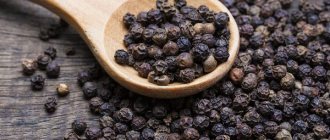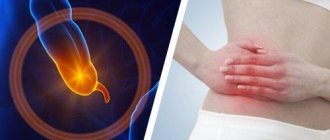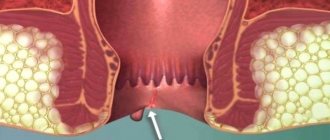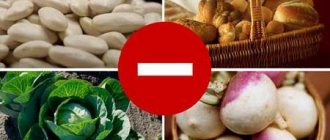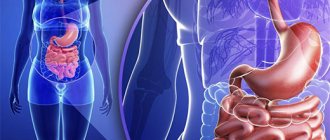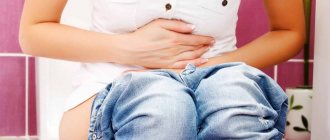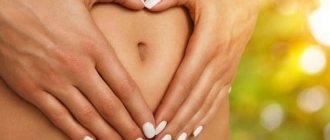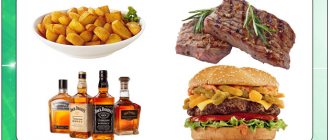If unpleasant sensations rarely occur as a result of a sudden change in your usual diet or lifestyle, there is no cause for concern. When pain in the lower abdomen becomes regular, you need to think as quickly as possible about the causes and ways to restore health.
Discomfort in an adult or child may indicate either a temporary malfunction or the presence of a serious pathology of the digestive system. Characteristic symptoms develop when chaotic contraction of smooth muscle muscles in the lower abdomen begins. As a result, lactic acid accumulates in the cells, irritating the nerve endings. This causes moderate to severe pain.
Why does my intestines hurt?
Negative processes develop under the influence of the following provoking factors:
- Inflammation of the intestinal mucous structures lining the walls. The root cause is autoimmune mechanisms or infection in the body. If the small intestine is affected, enteritis is diagnosed, and the large intestine is diagnosed with colitis. In the event of a pathological process in the appendix, appendicitis is diagnosed, requiring surgical intervention.
- Failure of the immune system. As a result, antibodies are actively produced against intestinal tissues. Without treatment, a complication in the form of ulcerative colitis is possible.
- Parasitic infestation. The prolonged presence of helminths (such as roundworms, pork or bovine tapeworms, tapeworms) contributes to poisoning of the body. Intoxication and mechanical injury are the main causes of severe pain.
- Dysbacteriosis. When the balance of beneficial and conditionally pathogenic flora is disturbed with a predominance of the second component, food digestion occurs with increased gas formation and intestinal bloating. At the same time, bacterial toxins accumulate, which leads to the development of pain.
- Chronic inflammation of the pancreas. This process is accompanied by reduced production of digestive enzymes, which negatively affects the functioning of both the stomach and intestines. The result is pronounced fermentation processes, flatulence, and spasms.
- Insufficient peristalsis or atony. With this disorder, digested food accumulates in the lower gastrointestinal tract, causing severe stretching of the walls and pain.
- Mesenteric thrombosis. When the arteries responsible for nutrition are blocked, necrosis develops. Even strong painkillers cannot cope with this situation.
- Intestinal obstruction. If there is an acute process with active tumor growth or blocking of the lumen by a foreign body, the movement of food masses becomes difficult. The result is a strong spasm.
- Ischemia. Against the background of impaired vascular patency, intense cramping pain appears throughout the intestine. The risk group includes patients with varicose veins, diabetes, and atherosclerosis.
- Polyposis. Overgrowth of mucous membrane in the colon.
- Crohn's disease. If left untreated, the pathology is dangerous with a high probability of developing cancer.
- Chemotherapy. The cells of the gastrointestinal tract are damaged or destroyed.
Pain in the lower abdomen often accompanies late pregnancy or becomes a manifestation of irritable bowel syndrome. In both cases, the situation can be corrected by revising the diet.
Video: Irritable bowel syndrome
Traditional medicine recipes
Before you start using alternative medicine, you should conduct a thorough examination of the inflamed organ and obtain a diagnosis.
If the conclusion allows you to use traditional medicine to treat the problem, then you can choose a method of therapy for a specific case. Traditional recipes are good for pregnant women and people who are contraindicated in taking synthetic drugs. In addition, they are quite economical and their use does not cause side effects. It is necessary to keep in mind the individual intolerance of certain substances by the body of a particular person.
Cleansing the body
Before you heal your intestines at home, you should cleanse your digestive system. People with chronic diseases of the digestive system should not carry out self-cleansing of the body. The following cleansing methods are popular:
- Infusion of flax seeds. A tablespoon of seeds should be poured into half a glass of warm water and left for 2 hours. After this, add half a glass of oil to the infusion, stir and drink before meals. The course of cleansing is 7 days.
- Oatmeal decoction. A glass of oatmeal should be poured into 2 liters of boiled water and the mixture should be left to steep for 24 hours. After this, put the pan on the fire and cook the jelly for an hour. After this time, the broth should be cooled, filtered and drunk all day, replacing food with it. In addition to jelly, only water is allowed on this day. After such a fasting day, you should take a break of 5 days, after which you can repeat the process again, gradually increasing the duration of cleansing with oatmeal jelly to four days.
Elimination of irritable bowel syndrome
With this disease, treatment of the intestines with folk remedies is even more effective than therapy using drugs. Most often, tea or herbal infusions are used as a life-saving elixir:
- Mint infusion to reduce gas formation and relieve cramps. In a cup of boiling water, infuse a spoonful of mint leaves. The infusion should be drunk 2 times a day, half a glass, an hour before meals.
- A remedy for eliminating spasms and normalizing digestion. Infuse a spoonful of dill seeds in 200 ml of boiling water for 2 hours. To treat the intestines, you need to drink ½ glass of the infusion three times a day.
- Dry sage elixir for diarrhea and vomiting. A tablespoon of the herb should be brewed in boiling water (3 cups) and left for an hour, then drink a glass of the product three times a day.
- Kefir with vegetable oil for constipation. You need to add a spoonful of oil to a glass of kefir, stir and drink the mixture before bed.
- As a remedy for constipation, you can eat baked apples, dried prunes, and drink a spoonful of olive oil in the morning before meals.
- Infusions, decoctions and alcohol tinctures on oak bark help well against diarrhea.
Treatment of dysbiosis
The fight against this disease, which disrupts the intestinal microflora, occurs in three stages. Toxins are removed, pathogenic bacteria and fungi are removed, and the natural balance of microorganisms is restored:
- Treatment of the intestines with herbs: the best remedy for restoring microflora. St. John's wort, chamomile, lemon balm, and flaxseed should be taken in equal proportions, crushed and mixed. After this, you need to leave a spoonful of this mixture in two glasses of boiling water for 24 hours. Drink a glass of the composition on an empty stomach 3 times a day before meals for 7 days.
- Aloe with wine to combat dysbiosis. To prepare the product, grind 100 g of aloe using a meat grinder, place in a glass jar, add 200 g of granulated sugar, close and leave to infuse for 3 days. After this time, pour 200 g of red wine into the mixture and leave for another 24 hours. You can treat the intestines by taking the prepared elixir, a tablespoon three times a day before meals (half an hour).
Therapy for peptic ulcer
With a duodenal ulcer, excessive formation of hydrochloric acid occurs, resulting in pain, often radiating to the back, shoulder blade and heart. The disease also manifests itself in the form of heartburn, nausea, high gas formation, constipation, and weight loss often occurs.
- Infusion of sea buckthorn oil and propolis. Infuse propolis powder in half a glass of oil for half an hour. Add a few drops of tocopherol solution (prepare in a ratio of 1:10), mix and put in a dark place. Take the elixir three times a day, a teaspoon.
- Licorice decoction. Grind licorice root (10 g) and orange peel (6 g), pour half a glass of boiling water over them. Place the mixture on the stove and evaporate until half the original volume remains. Add honey in an amount of 50 g. Drink the resulting product in equal parts three times during the day. The course of taking the elixir is 30 days.
- For peptic ulcers, it is also useful to drink half a glass of potato decoction (without salt) or cabbage juice three times a day before meals.
Treatment of colitis
This disease, affecting the large and small intestines, is accompanied by damage to the mucous membranes of these diseased sections. Symptoms of colitis include pain in the navel, bloating, loss of appetite, and frequent urge to defecate. In mild forms of the disease, you can treat the intestines at home using folk remedies.
To treat chronic colitis, you can use a mixture of herbs, which includes: yarrow, sage, mint, oregano, plantain, shepherd's purse, St. John's wort, knotweed. You should also add caraway seeds, valerian root, chamomile flowers and blueberries. It takes an hour to infuse two tablespoons of herbs in a glass of boiling water. You need to drink half a glass after meals.
You can calm the intestines and relieve exacerbations with the help of sprouted wheat. It should be washed, dried and crushed in a blender. From the resulting powder you can cook porridge (in water), to which, once ready, it is recommended to add a little honey.
For the treatment of colitis, microenemas with sea buckthorn oil have proven themselves to be effective. Before this procedure, you should cleanse the intestines with an enema of a mixture of St. John's wort and chamomile brewed in 0.5 liters of hot water. Sea buckthorn oil in an amount of 50 ml is injected into the anus in a supine position. These procedures are carried out within a month.
If the methods of treating the disease do not produce the expected effect, you should contact your doctor again.
Digestive problems of various types occur in every person at least once in their life. According to medical statistics, diseases of the gastrointestinal tract are among the five most common diseases of humanity.
The most common pathologies are irritable bowel syndrome and microflora disorders (dysbiosis of the small and large intestines), inflammatory processes in the intestines (enteritis, colitis), ulcerative lesions of the intestinal mucosa (Crohn's disease, ulcerative colitis).
Symptoms of pain in the intestines
Unpleasant sensations in the abdomen can be of a different nature:
- Intense acute spasm. Short-term attacks accompany poisoning, infection, appendicitis, and long-term attacks accompany dysbiosis, nonspecific ulcerative colitis.
- Pain after eating.
- Aching discomfort is characteristic of sluggish chronic inflammation.
- Spasms in the form of contractions.
Considering exactly where the intestines hurt, we can make an assumption about the causes of the pathology:
- Unpleasant sensations on the lower right indicate appendicitis.
- If you are concerned about discomfort on the side on the left side, it is worth examining the sigmoid colon.
- When the lower abdomen hurts in the center, enteritis is possible.
- A diffuse spasm indicates damage to all parts - enterocolitis.
These bodies include:
- Organs associated with digestion are the stomach, tissues at the end of the esophagus, small and large intestines, liver, gallbladder and pancreas.
- The abdominal aorta is a large blood vessel that runs straight from the chest into the abdominal cavity.
- The kidneys are two bean-shaped organs that lie deep in the abdominal cavity.
However, there are times when the pain may come from another location, such as the chest or pelvic area. It could also be a generalized infection, such as the flu or strep throat, that affects the entire body. In addition, pain of intestinal origin can be localized anywhere, since the boundaries of the abdomen are quite large. The abdomen is an anatomical region that borders the lower edge of the ribs and above, the pelvic bones on each side. Therefore, the pain can radiate to these areas and be quite severe.
What to do if your intestines hurt
You can choose appropriate methods to eliminate spasms only after identifying the cause of the discomfort. To achieve this, a number of diagnostic measures are planned:
- Stool analysis is a coprogram. Based on the results obtained, you can understand how complete the process of food digestion is.
- Bacteriological analysis is advisable if you need to determine the causative agent of an infection or understand how beneficial and pathogenic intestinal flora are distributed.
- Endoscopy. To do this, a fiber optic tube equipped with a camera is passed through the stomach, assessing the structure of the mucosa.
- X-ray examination is carried out using a contrast agent (barium mixture). With its help, it is possible to assess how much the intestinal walls have changed and how the digested food is progressing.
When it is not clear what medications for pain are needed at a particular moment, before visiting a doctor or arriving in an ambulance, it is recommended:
- Drink an antispasmodic. In most cases, No-shpa gives a good effect.
- Find the optimal body position in which the spasm subsides.
- If the condition is restored within half an hour, they move on to procedures that heal the intestines. You can start with a abdominal massage.
- When bloating is severe, taking special medications will not hurt. For example, drinking Smecta or activated carbon.
Certain points are discussed depending on the type of spasm.
Acute pain
In this situation, taking painkillers at home will not work. It is necessary to call an ambulance as quickly as possible, since a doctor must prescribe therapy. Before his arrival, the patient needs complete rest.
Blunt pain
The cause of discomfort can be either minor or quite serious. Intestinal volvulus, massive helminthiasis, adhesions or a tumor process cannot be ruled out. Treatment, as in the previous case, is long-term and is prescribed only after a thorough examination.
Throbbing pain
As a rule, the occurrence of acute cramps is not dependent on food intake or physical activity. The peculiarity of the condition is the rapid relief of the syndrome and its return over time. For relief, they take antispasmodics, but if the attack recurs, be sure to go to the doctor.
Video: Five early signs of colon cancer
Pain after eating
If there is a direct connection between nutrition and cramps, the main cause of the negative condition is excess stress on the stomach and irritation of the mucous membrane. When nighttime discomfort predominates, an ulcer may be suspected.
To smooth out the symptoms, exclude spicy, heavy foods from the diet, and refuse dry snacks. It is also undesirable to eat foods that are too cold or hot.
Constant pain
A common pathology with long-lasting cramps is irritable bowel syndrome. It occurs with stool disorder. Both diarrhea and difficulty going to the toilet due to constipation are possible. Both conditions are accompanied by severe spasms and flatulence.
Types of diseases
There are several diseases that interfere with the intestines performing their functions and impair human life. It is extremely important not to neglect them and to carry out timely treatment.
Intestinal diseases can manifest themselves as:
- colitis;
- enteritis;
- hemorrhoids;
- duodenal ulcers;
- intestinal obstruction;
- irritable bowel syndrome;
- dysbacteriosis;
- duodenitis;
- dysentery;
- appendicitis;
- candidiasis;
- proctitis;
- the appearance of malignant and benign neoplasms.
Advanced forms of some diseases can lead to dire consequences: typhoid fever or tuberculosis.
When visiting a doctor, intestinal examinations are carried out using several methods:
- blood and stool tests;
- palpation of the abdominal area;
- x-ray;
- MRI;
- Ultrasound;
- computed tomography;
- sigmoidoscopy.
When problems with the intestines occur, an important role is played by monitoring the composition and standards of nutrition. Diet is important for successful treatment. You should exclude the consumption of fatty meat, milk, spicy foods, alcohol, pickles, sweets, and foods that can irritate the intestines. At the same time, it is necessary to include foods containing calcium, potassium and proteins in your daily diet as often as possible. Meals should be small and frequent. You need to drink at least two liters of water per day. It is also extremely important to monitor personal hygiene, the observance of which minimizes the risk of infectious inflammation.
What to take for intestinal pain
To eliminate spasms in situations where surgical intervention is not indicated, complex etiotropic therapy is practiced:
- Taking antibiotics – medications are needed if an infection is diagnosed.
- Probiotics - the need for live bacteria is present when tests confirm an imbalance and there is stool disorder.
- Immunosuppressants. They are taken by patients with ulcerative colitis and intestinal obstruction. The goal of therapy is to reduce immune activity.
At the same time, pathogenetic treatment is planned to ensure proper functioning of the digestive system. The list consists of several items:
- Enzymatic agents. They help speed up the digestion process, eliminating stagnation and fermentation of food. The tablets are taken strictly following the instructions - it is important to accurately determine the dosage and observe the time intervals.
- Sorbents. Pharmacy drugs in this group help rid the body of harmful substances. If, in the presence of spasms, the patient feels nauseous and has severe skin problems (rashes, peeling appear), measures to remove toxins become a priority.
Treatment is also not complete without antispasmodics, which affect the main symptoms. In addition to traditional No-shpa, new generation myotropic drugs can be prescribed. These include Duspatalin, which affects intestinal smooth muscles without disrupting peristalsis. When the situation is aggravated by the inflammatory process, non-steroidal drugs are introduced into the regimen to relieve pain.
Pharmaceuticals
Today, the pharmaceutical market offers a variety of tablets that help relieve symptoms of intestinal diseases. Doctors mainly use the following groups of drugs:
- antispasmodics;
- laxatives;
- carminative;
- sorbents;
- probiotics.
Antispasmodics
Antispasmodics are those whose main task is to relieve spasms and pain. Most often, doctors prescribe No-shpa, Drotaverine, Mebeverine, Duspatalin. The tablets quickly eliminate symptoms and improve the patient's condition.
Laxatives
Laxatives help relieve constipation. Recently, lactulose-based drugs, for example Duphalac, have become increasingly popular. They contain dietary fiber, which increases the volume and reduces the density of stool, making it soft and effective.
Carminative
The most popular drug from this group is Espumisan. Simethicone, which is part of it, splits large gas bubbles into smaller ones, which are easily removed from the body.
Sorbents
The main task of sorbents is to remove toxins that have accumulated in the intestines and cause unpleasant symptoms. The simplest remedy in this group is activated carbon. Nowadays, new, more effective drugs have been developed that can adsorb toxins on themselves - Smecta, Atoxil, Enterosgel.
Probiotics
Preparations containing bifidobacteria and lactobacilli. Normally, these bacteria inhabit the intestinal mucosa and prevent the adhesion of pathogenic microorganisms to it. When the microbiological balance is disturbed, favorable conditions are created for the growth and development of pathogenic bacteria. Outwardly, this manifests itself as pain in the intestines and disruption of its functioning.
Diet for the intestines
If you regularly experience discomfort in the abdomen, meals are planned based on the functioning of the gastrointestinal tract. For constipation, adhere to the following recommendations:
- It is healthy to eat whole grain or bran bread, but in minimal quantities.
- Fruits and vegetables should be present in abundance.
- Preferred cereals are barley, wheat, pearl barley, and buckwheat.
- Meat and fish are taken only of lean varieties. Carrots, cabbage, and beets are added to the broths.
- You can drink non-carbonated purified water, fresh or dried fruit compote, diluted juices, tea.
Sweets with gelatin, jelly, and baked goods made from premium flour are prohibited.
If there is a tendency to diarrhea, a diet is planned that eliminates irritation of the mucous membrane:
- Porridge is served only pureed.
- Meat and fish are cooked to a soufflé consistency.
- Soups are cooked without adding potatoes or pasta and whipped until pureed.
- Cutlet and minced fish are made with rice.
- Among berries and fruits, preference is given to fruits with astringent properties: quince, blueberry, dogwood.
In both cases, in order to relieve spasms, strong tea and coffee, onions, garlic, and radishes are excluded from the menu.
Nutritional Features
Many people are interested in what they can eat in this case. The diet for intestinal pain is based on the following rules:
- Eliminate heavy foods . Experts advise avoiding fried and fatty foods, smoked foods, coffee, carbonated drinks, and baked goods. As a result of eating such food, processes of rotting and fermentation develop in the intestines.
- Choose steaming food.
- Eat small meals 4-5 times a day . It is especially important to avoid overeating before bed. At night, intestinal motility slows down.
- Eat a lot of vegetables, fruits and greens . These products contain fiber, which is required for normal peristalsis.
- Maintain drinking regime . You need to drink at least 1.5 liters of clean water per day. It is not recommended to combine liquid intake with food.
To achieve good results, diet therapy must be long-term. It is best to adhere to the principles of a healthy diet even after eliminating the unpleasant manifestations of pathology.
Pain in the intestines can be a symptom of a variety of diseases. To cope with unpleasant manifestations, it is very important to promptly identify the provoking factor and take measures to eliminate it.
Diagnosis of lower abdominal pain
What diagnostic methods does a specialist use to determine the cause of the disease:
- Taking an anamnesis - the doctor interviews the patient, finds out the nature of the pain in the intestines, the presence of concomitant symptoms and chronic diseases.
- When examining a patient, the doctor palpates the abdomen , examines the lymph nodes and checks the sclera of the eyes.
- Directions for research are given:
- coprogram and stool culture tank;
- fibrogastroduenoscopy - examination of the upper intestines;
- colonoscopy - lower sections;
- irrigoscopy - intestinal x-ray with contrast.
Which doctor should I contact?
Doctors of several specialties deal with intestinal problems:
- gastroenterologist;
- proctologist;
- oncologist.
A final consultation is needed only if malignant processes are suspected.
If serious failures are excluded, stomach problems are easily solved. A review of habits, giving up a sedentary lifestyle and indigestible food comes to the rescue. Relaxing techniques that have a positive effect on both the nervous system and the gastrointestinal tract will also help improve your condition.
Loading… Source: projivot.ru
